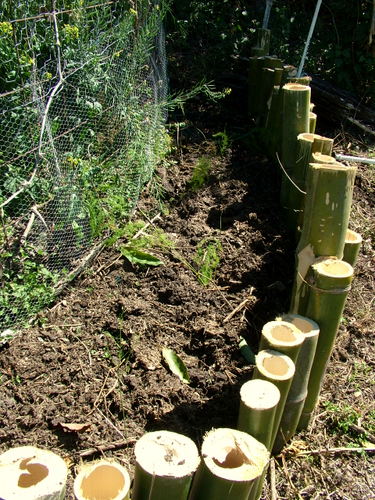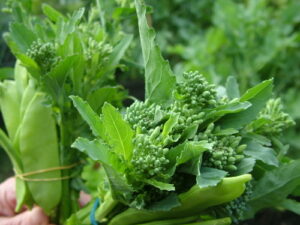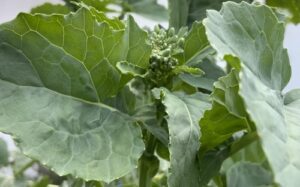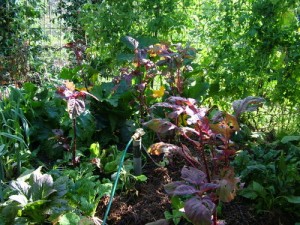Very early spring in fact. The very first day. Today and tomorrow are roots and perennials planting days by the lunar planting calendar that I use, more to keep me from procrastination than anything else. It gives me an artificial deadline that means I tend to be likely to whack something in the ground most weeks, and my garden rewards me.
I am putting in a regular round of carrots and beets and spring onions. And tomorrow I’m going to transplant the oregano, which is getting a bit old and stale in the spot it is in and needs transplanting to a new, nutrient rich spot in full sun. I have a few seedlings of bush lemons that have come up on their own from compost, that I might get around to planting out, though those of you who have been here before will understand why it isn’t a priority.
I also today planted out a new bed of asparagus, with seedlings propagated when my mature plants seeded last autumn. The wallabies looooove asparagus, possibly better than anything else in my garden except maybe the sugar cane. If they get in they make a beeline for it. With the result that I have re-established asparagus beds so many times I’ve lost count.
If I can get it established, it can bear well outside my intensively fenced beds but inside the (supposedly) wallaby proof perimeter garden fence. I like planting it on the downhill, northeast side of the beds where it captures nutrient and water runoff and dies off in winter so as not to shade the beds. The bower birds, bush turkeys and possums leave it alone and once it is established, it is bandicoot proof. Once it is established. If I just plant it and water it, they dig it up the first night. This is my latest attempt to foil them – a fence made from the giant bamboo we have growing. It won’t last long, but it only has to last a few months till they are established enough to resist being just dug up. Fingers crossed.
But the exciting planting this time is cassava. I’ve never grown cassava, and I don’t know why. It should do well here, and I’ve eaten it in Cuba and liked it. The cuttings in the top photo were given to me by Camilla (thanks Camilla!). They are planted in a polystyrene box of compost mixed with a little sand. I’ll put another inch or so of compost on top, then keep them watered in the shadehouse till they are established. My research says they like well drained soil but can cope with poor soil. And they can grow up to 5 metres tall.





Wow! I can’t believe it but I just planted carrots, beet root, parsnips today. I keep meaning to get a calendar but haven’t got to it yet. I hope the same goes for Victoria.
I also put manure and mulch on the rhubarb and asparagus. Does a roots and perennial day include tending or just planting?
Good luck with the asparagus. I love fresh asparagus, one of the few veggies I eat straight from the garden. I can see why you would be tenacious with them.
Great website. I’m interested in the cassava, having eaten it in various countries in Southeast Asia. Are you growing it for the leaves, or for the starch from the roots? I’ve been thinking about trying it here – we are on well drained sandstone country in the Helidon Hills west of Brisbane. However I have been wary of getting a variety with high concentrations of cyanide in the leaves. The processing of the roots is designed to remove any cyanide, but one can’t really process the leaves.
Hi Gordon, I know very little about it yet! This is the first time I have grown it. I suspect I will be more interested in the roots than the leaves. Leafy greens are not in short supply here, so they’d have to taste pretty good to be in the running. Even high protein levels doesn’t excite me that much. But we’re not in a good grain growing spot, so I’m always interested in substitutes. I’d love to hear from anyone who has experience growing and processing it.
Hi Linda, It goes by the phase of the moon, so it will be the same in Victoria. The idea is that the first quarter of the moon, as it goes from dark to half full is the best for leafy greens, then the next quarter up to full for fruiting annuals, then the next from full to half again for roots and perennials, then the last quarter for weeding. Within those quarters there are more and less fertile days, but I’m not so diligent about that. I use the lunar calendar to organise myself,to plant seeds and transplant, so that I am putting a new round of each kind of plant every month, without having to think about the lot all at once. It just keeps me on a roll.
Hi there
I am so impressed with your site and learnings great. i often tell my students in classes about it. I run fork in the field and have been running cooking sustainability classes and work locally.
Love what you are doing
Kind Regards
Alison